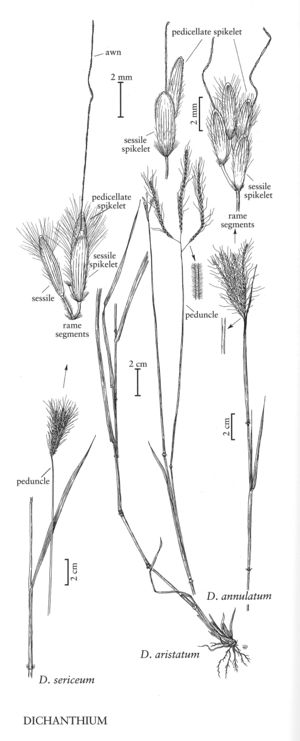Difference between revisions of "Dichanthium sericeum"
FNA>Volume Importer |
FNA>Volume Importer |
||
| Line 17: | Line 17: | ||
-->{{Treatment/Body | -->{{Treatment/Body | ||
|distribution=Pacific Islands (Hawaii);Fla.;Tex.;Miss. | |distribution=Pacific Islands (Hawaii);Fla.;Tex.;Miss. | ||
| − | |discussion=<p | + | |discussion=<p>Dichanthium sericeum is an Australian species. There are two subspecies: D. sericeum (R. Br.) A. Camus subsp. sericeum is a perennial with sessile spikelets 4-4.5 mm long and to 1-1.4 mm wide, 9-10-veined lower glumes, and rames more than 4 cm long; D. sericeum subsp. humilius (J.M. Black) B.K. Simon is an annual, with sessile spikelets up to 4 mm long and about 1 mm wide, 5-7-veined lower glumes, and rames less than 4 cm long. Dichanthium sericeum subsp. sericeum is established in Texas and Florida.</p> |
|tables= | |tables= | ||
|references= | |references= | ||
| Line 33: | Line 33: | ||
|basionyms= | |basionyms= | ||
|family=Poaceae | |family=Poaceae | ||
| + | |illustrator=Linda A. Vorobik and Hana Pazdírková | ||
|distribution=Pacific Islands (Hawaii);Fla.;Tex.;Miss. | |distribution=Pacific Islands (Hawaii);Fla.;Tex.;Miss. | ||
|reference=None | |reference=None | ||
| Line 38: | Line 39: | ||
|publication year= | |publication year= | ||
|special status= | |special status= | ||
| − | |source xml=https:// | + | |source xml=https://bibilujan@bitbucket.org/aafc-mbb/fna-data-curation.git/src/314eb390f968962f596ae85f506b4b3db8683b1b/coarse_grained_fna_xml/V25/V25_1545.xml |
|subfamily=Poaceae subfam. Panicoideae | |subfamily=Poaceae subfam. Panicoideae | ||
|tribe=Poaceae tribe Andropogoneae | |tribe=Poaceae tribe Andropogoneae | ||
Revision as of 17:16, 30 October 2019
Plants annual or perennial; tufted or cespitose. Culms 50-120 cm; nodes densely pilose, hairs about 2 mm. Sheaths with scattered papillose-based hairs; ligules 1-2 mm; blades 5-25 cm long, 2-5 mm wide. Rames 1-7, 3-7 cm, subdigitate, often glaucous and white-villous, spikelet-bearing to the base, basal spikelet pairs consisting only of glumes; internodes pubescent, hairs immediately below the nodes to 1.5 mm. Sessile bisexual spikelets 2.5-4.5 mm long, 1-1.4 mm wide; lower glumes 5-10-veined, with 0.7-1.5 mm hairs on the basal 1/2 and about 3 mm papillose-based hairs on the distal portion of the keels and in a transverse subapical arch; awns 2-3.5 cm, twice-geniculate. Pedicellate spikelets about 3 mm, usually sterile. 2n = 20.
Distribution
Pacific Islands (Hawaii), Fla., Tex., Miss.
Discussion
Dichanthium sericeum is an Australian species. There are two subspecies: D. sericeum (R. Br.) A. Camus subsp. sericeum is a perennial with sessile spikelets 4-4.5 mm long and to 1-1.4 mm wide, 9-10-veined lower glumes, and rames more than 4 cm long; D. sericeum subsp. humilius (J.M. Black) B.K. Simon is an annual, with sessile spikelets up to 4 mm long and about 1 mm wide, 5-7-veined lower glumes, and rames less than 4 cm long. Dichanthium sericeum subsp. sericeum is established in Texas and Florida.
Selected References
None.
